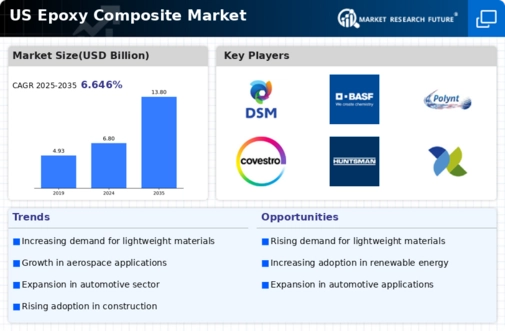The epoxy composite market exhibits a dynamic competitive landscape characterized by innovation and strategic partnerships. Key players such as Hexcel Corporation (US), Huntsman Corporation (US), and Sika AG (US) are actively shaping the market through their distinct operational focuses. Hexcel Corporation (US) emphasizes advanced materials and aerospace applications, while Huntsman Corporation (US) is leveraging its expertise in specialty chemicals to enhance product performance. Sika AG (US) is strategically positioned in construction and industrial applications, focusing on sustainable solutions. Collectively, these strategies foster a competitive environment that prioritizes technological advancements and market responsiveness.
In terms of business tactics, companies are increasingly localizing manufacturing and optimizing supply chains to enhance efficiency and reduce costs. The market structure appears moderately fragmented, with several key players exerting influence over specific segments. This fragmentation allows for niche players to thrive, while larger corporations consolidate their market positions through strategic acquisitions and partnerships.
In November 2025, Hexcel Corporation (US) announced a collaboration with a leading aerospace manufacturer to develop next-generation lightweight composite materials. This partnership is poised to enhance Hexcel's product offerings and strengthen its foothold in the aerospace sector, reflecting a broader trend towards innovation in high-performance materials. The strategic importance of this collaboration lies in its potential to drive revenue growth and expand market share in a competitive landscape.
In October 2025, Huntsman Corporation (US) unveiled a new line of epoxy resins designed for high-temperature applications in the automotive industry. This launch underscores Huntsman's commitment to innovation and its ability to meet evolving customer demands. By addressing specific industry needs, the company positions itself as a leader in specialized epoxy solutions, which may enhance its competitive edge.
In September 2025, Sika AG (US) completed the acquisition of a regional epoxy resin manufacturer, thereby expanding its product portfolio and market reach. This strategic move not only diversifies Sika's offerings but also strengthens its supply chain capabilities. The acquisition reflects a trend towards consolidation in the market, as companies seek to enhance their competitive positioning through strategic growth initiatives.
As of December 2025, current competitive trends indicate a strong emphasis on digitalization, sustainability, and the integration of AI technologies within the epoxy composite market. Strategic alliances are increasingly shaping the landscape, enabling companies to leverage complementary strengths and enhance innovation. Looking ahead, competitive differentiation is likely to evolve, shifting from price-based competition to a focus on technological advancements, sustainability, and supply chain reliability. This transition suggests that companies prioritizing innovation and strategic partnerships will be better positioned to thrive in an increasingly complex market.





















Leave a Comment